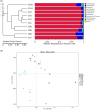Microbial community structure and biogenic amines content variations in chilled chicken during storage
- PMID: 36789075
- PMCID: PMC9922133
- DOI: 10.1002/fsn3.3122
Microbial community structure and biogenic amines content variations in chilled chicken during storage
Abstract
The aim of this study was to investigate the sensory indicators, biogenic amine contents, and bacterial community structure and diversity of chilled chicken stored at 4°C under aerobic conditions. Bacterial diversity and dominant bacteria were analyzed using high-throughput sequencing technique (HTS). The relationship between biogenic amine contents and microbial community structure was studied. The results showed that contents of putrescine and cadaverine increased significantly with storage time. Proteobacteria was absolutely dominant flora at the phylum level. The predominant spoilage bacteria found in chicken thighs were Pseudomonas, Acinetobacter, Aeromonas, Shewanella, and Yersinia, and the difference with chicken breasts was related to the presence of Myroides and absence of Yersinia. Myroides, Yersinia, and Shewanella were reported for the first time as an important contributor to the spoilage-related microflora. Bacterial diversity and richness indices showed fluctuating and decreasing trend with storage time. The redundancy analysis showed that the relative abundance of Pseudomonas, Yersinia, and Janthinobacterium was positively related to the contents of putrescine, cadaverine, and tyramine, while Shewanella and Aeromonas showed positive relationship with putrescine content. Furthermore, positive relationship of Myroides and Desulfovibrio with the contents of cadaverine and tyramine was proposed for the first time. The key findings of this study can provide experimental data for food safety monitoring during refrigerated storage and preservation for poultry meat products.
Keywords: bacterial community structure and diversity; biogenic amine contents; chilled chicken; high‐throughput sequencing technique.
© 2022 The Authors. Food Science & Nutrition published by Wiley Periodicals LLC.
Figures





Similar articles
-
Correlation between microbial flora, sensory changes and biogenic amines formation in fresh chicken meat stored aerobically or under modified atmosphere packaging at 4 degrees C: possible role of biogenic amines as spoilage indicators.Antonie Van Leeuwenhoek. 2006 Jan;89(1):9-17. doi: 10.1007/s10482-005-9003-4. Epub 2006 Mar 10. Antonie Van Leeuwenhoek. 2006. PMID: 16528580
-
Effect of cinnamon essential oil on bacterial diversity and shelf-life in vacuum-packaged common carp (Cyprinus carpio) during refrigerated storage.Int J Food Microbiol. 2017 May 16;249:1-8. doi: 10.1016/j.ijfoodmicro.2016.10.008. Epub 2016 Oct 11. Int J Food Microbiol. 2017. PMID: 28271852
-
Formation of biogenic amines and growth of spoilage-related microorganisms in pork stored under different packaging conditions applying PCA.Meat Sci. 2014 Feb;96(2 Pt A):843-8. doi: 10.1016/j.meatsci.2013.09.023. Epub 2013 Oct 5. Meat Sci. 2014. PMID: 24200579
-
Biogenic amines in fish: roles in intoxication, spoilage, and nitrosamine formation--a review.Crit Rev Food Sci Nutr. 2009 Apr;49(4):369-77. doi: 10.1080/10408390802067514. Crit Rev Food Sci Nutr. 2009. PMID: 19234946 Review.
-
Biogenic Amines in Poultry Meat and Poultry Products: Formation, Appearance, and Methods of Reduction.Animals (Basel). 2022 Jun 18;12(12):1577. doi: 10.3390/ani12121577. Animals (Basel). 2022. PMID: 35739911 Free PMC article. Review.
Cited by
-
Facile Synthesis of Ag NP Films via Evaporation-Induced Self-Assembly and the BA-Sensing Properties.Foods. 2023 Mar 17;12(6):1285. doi: 10.3390/foods12061285. Foods. 2023. PMID: 36981211 Free PMC article.
References
-
- Altun, S. , Büyükekiz, A. G. , Duman, M. , Özyiğit, M. , Karataş, S. , & Turgay, E. (2014). Isolation of Shewanella putrefaciens from goldfish (Carassius auratus auratus). The Israeli Journal of Aquaculture‐Bamidgeh, 66, 1–7.
-
- Baixas‐Nogueras, S. , Bover‐Cid, S. , Veciana‐Nogués, M. T. , & Vidal‐Carou, M. C. (2003). Amino acid‐decarboxylase activity in bacteria associated with Mediterranean hake spoilage. European Food Research and Technology, 217(2), 164–167.
-
- Balamatsia, C. C. , Paleologos, E. K. , Kontominas, M. G. , & Savvaidis, I. N. (2006). Correlation between microbial flora, sensory changes and biogenic amines formation in fresh chicken meat stored aerobically or under modified atmosphere packaging at 4°C: Possible role of biogenic. Antonie Van Leeuwenhoek, 89(1), 9–17. 10.1007/s10482-005-9003-4 - DOI - PubMed
-
- Balamatsia, C. C. , Patsias, А. , Kontominas, M. G. , & Savvaidis, I. N. (2007). Possible role of volatile amines as quality‐indicating metabolites in modified atmosphere‐packaged chicken fillets: Correlation with microbiological and sensory attributes. Food Chemistry, 104(4), 1622–1628. 10.1016/j.foodchem.2007.03.013 - DOI
Publication types
LinkOut - more resources
Full Text Sources

